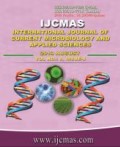


 National Academy of Agricultural Sciences (NAAS)
National Academy of Agricultural Sciences (NAAS)

|
PRINT ISSN : 2319-7692
Online ISSN : 2319-7706 Issues : 12 per year Publisher : Excellent Publishers Email : editorijcmas@gmail.com / submit@ijcmas.com Editor-in-chief: Dr.M.Prakash Index Copernicus ICV 2018: 95.39 NAAS RATING 2020: 5.38 |
The study was conducted during 2018-19 in Mandya district of Karnataka State, India. The pre-tested interview schedule was used to collect the data from 120 Seasamum growers through personal interview method. The collected data was tabulated and analyzed using percentages, correlation and regression. As high as 44.17 per cent of Seasamum growers belonged to medium level adoption category, 35.00 per cent to low adoption category and 20.83 per cent belonged to high adoption category. Majority of the Seasamum growers completely adopted the recommended cultivation practices such as, selection of suitable soil, time of planting, recommended depth of planting, inter cultivation, hand weeding, thinning for maintaining plant population, time of harvesting and post harvest practices. Further, majority of Seasamum growers partially adopted the recommended cultivation practices such as, recommended quantity of seed rate, application of recommended quantity of FYM, time of application of FYM / compost, application of recommended quantity of nitrogen, phosphorus and potassium fertilizers,, recommended spacing, recommended yield and recommended storage practices. In addition, majority of the Seasamum growers not adopted the recommended cultivation practices such as, recommended varieties, application of recommended quantity of micro nutrients, seed treatment with recommended fungicide and application of recommended herbicide. The return per rupee of expenditure was 1.14. The major constraints expressed by Seasamum growers were low price, non availability of recommended varieties, non availability of high yielding varieties, lack of market information, lack of minimum support price, non availability of micro nutrients in smaller quantities and un scientific crop insurance.
 |
 |
 |
 |
 |